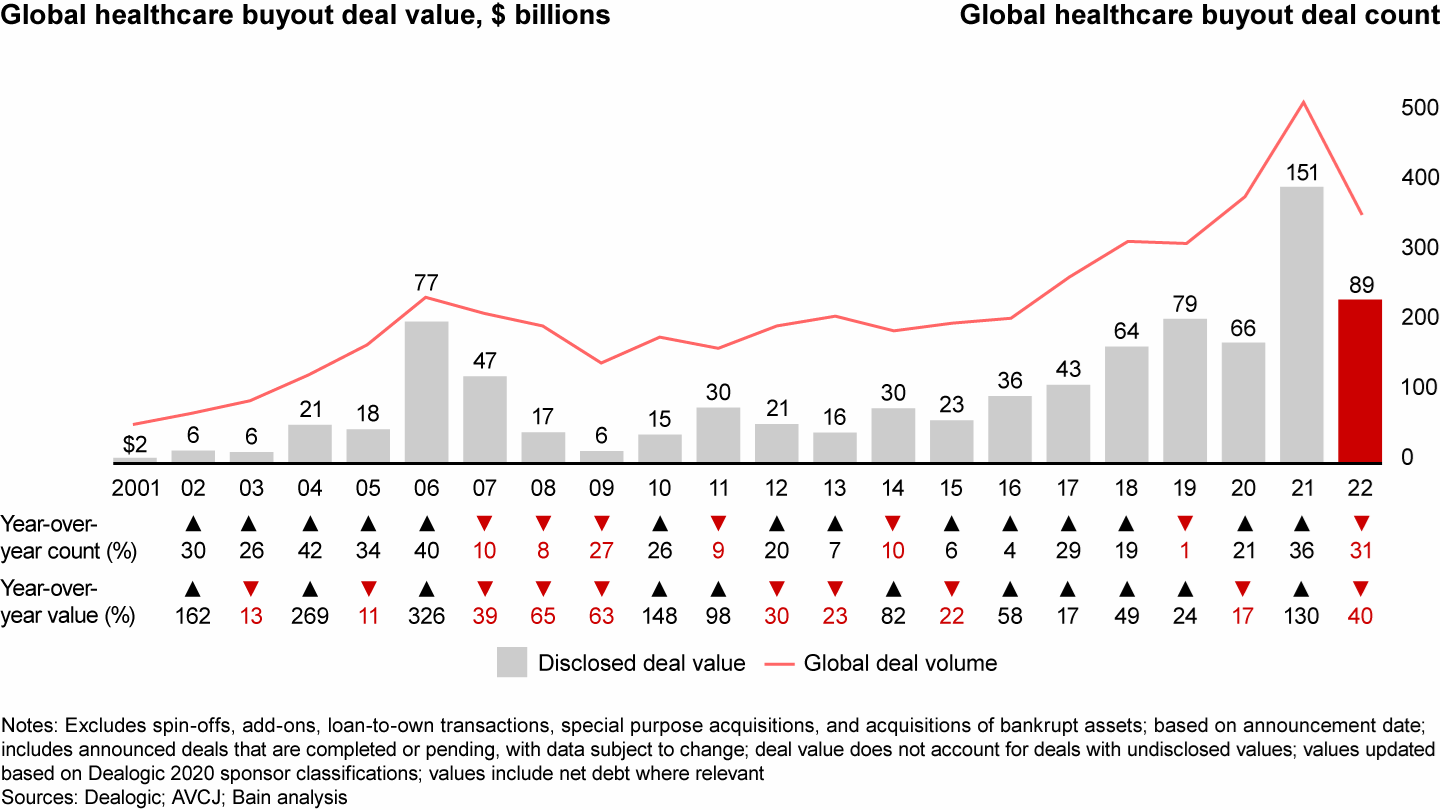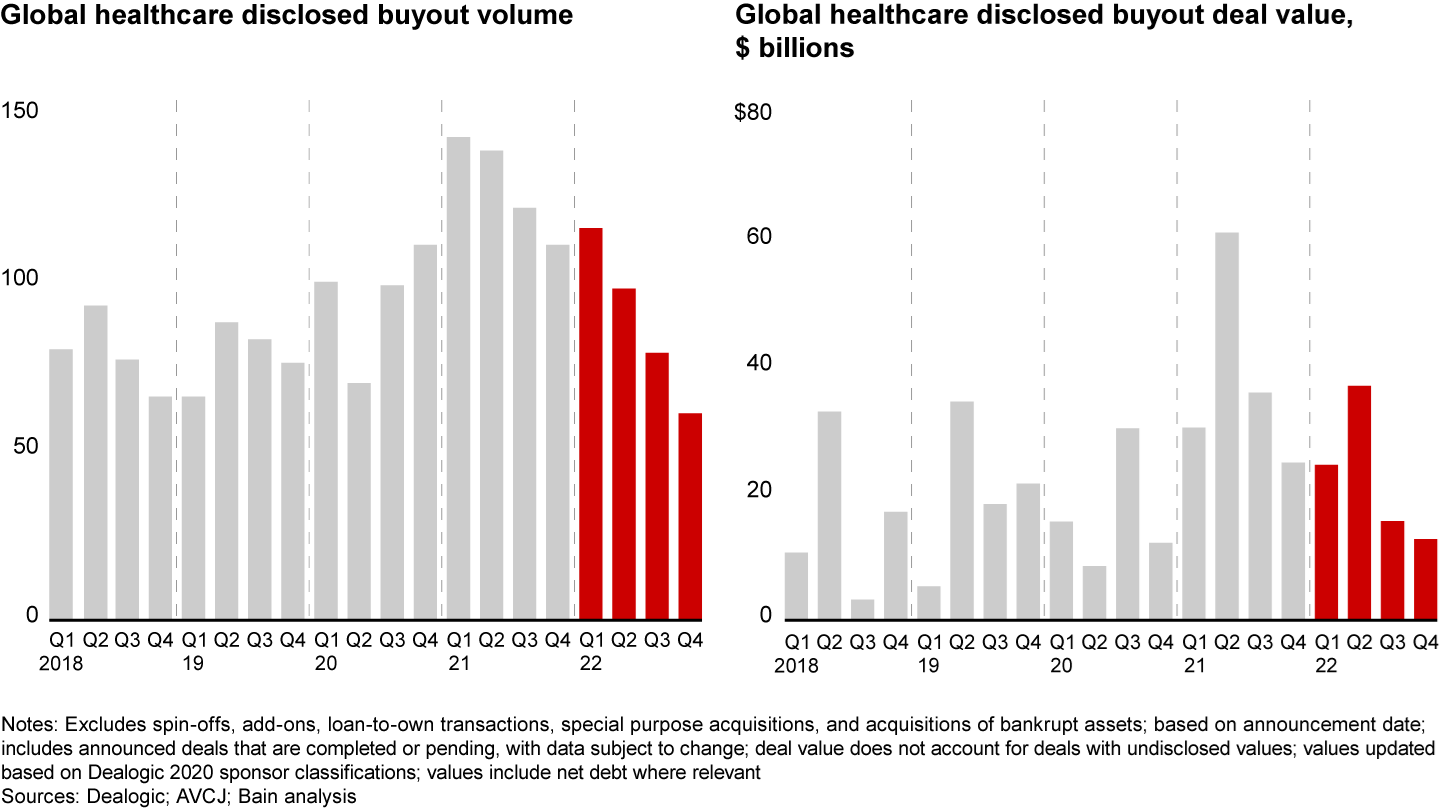Introduction
The healthcare industry saw a surge in M&A activity post-pandemic in 2021 which stretched across geographies and was driven by an incentive to consolidate healthcare systems to exploit economies of scale, fill pipelines, and boost top-line growth. In 2022, macroeconomic conditions, namely uncertainty, inflation, and high labour costs brought down both the volume and value of deals in the sector and saw VC funds reallocating their capital away from high-growth tech healthcare firms. Since the beginning of 2023, we have seen some major deals, such as Merck’s acquisition of Prometheus Biosciences for $10.8bn. Will this trend of high deal flow in the healthcare industry persist in today’s market environment?
Global Health Industry and Subsectors
The healthcare industry consists of businesses involved in providing medical services, medical insurance, and manufacturing medical drugs, equipment, and any other medical-related goods. The sector is one of the most important and fastest growing industries globally, with a total worldwide market value of over $11tn in 2022, which is expected to reach $19tn by 2029. The US healthcare industry, for example, accounted for 18.3% of the country’s Gross Domestic Product (GDP) in 2021, equivalent to $12,914 per person. The healthcare industry is a collection of a vast array of different sectors which overlap and can be difficult to identify. However, the entire industry is typically split into two main groups. The first is healthcare equipment and services, which include entities which provide medical supplies, equipment, and services, such as hospitals and various medical firms. The second subsector group is pharmaceuticals, biotechnology, and related life sciences, which is mostly made up of industrial medical production and research firms.
The medical equipment sector includes a range of producers from makers of standard products like bandages, face masks, and pacemakers to high-tech research and production firms that develop surgical robots, MRI scanners, and CT scanners. An example of such a firm is Medtronic plc [NYSE:MDT], the largest global medical device company. Managed Healthcare is an extremely important subsector of the healthcare industry in the US, due to the country’s lack of a universal healthcare program. Firms in this sector, such as UnitedHealth Group Incorporated [NYSE: UNH] provide health insurance policies to customers across the nation.
Biotechnology (biotech) and pharmaceutical (pharma) companies are often confused but are in many cases distinct firms. Both manufacture drugs, with the former producing medicines using living organisms called biologics, and the latter developing drugs using chemicals. Biotech and pharma products often have different regulatory proceedings due to the different forms of production. In the US, for example, a firm developing medical therapies using living organisms must seek approval from the U.S. Food and Drug Administration (FDA) by filing a Biologics License Application, whereas a pharma company must file a New Drug Application. The biotech industry is a much younger sector and is hence growing at a much faster pace, with new firms emerging alongside innovative medicines. Many biotech firms are smaller and are in the absence of reliable revenue sources, with FDA approval decisions causing major changes in firm market values. The COVID-19 pandemic in 2020 brought several biotech companies to light, including Regeneron [NASDAQ: REGN] and Moderna [NASDAQ: MRNA]. Both firms became household names during the pandemic, with Moderna developing Spikevax, a COVID-19 mRNA vaccine used worldwide, which still stands as their only commercial product. Regeneron developed a COVID-19 therapy named REGEN-COV2 which was famously used to treat former US president Donald Trump. Other leading biotech firms include Novo Nordisk A/S [NYSE: NV], BioNTech SE [NASDAQ: BNTX], and Vertex [NASDAQ: VRTX].
The pharmaceutical sector, on the other hand, is represented by large firms which usually focus on manufacturing and profiting from a varied portfolio of drugs, built up over many years, often decades, of research and development. Some examples of the top pharma firms, in order of revenue last year, include Pfizer [NYSE: PFE], Johnson & Johnson [NYSE: JNJ], F. Hoffmann-La Roche AG [SIX: ROG], and Merck [NYSE: MRK]. Pfizer, a New York-based pharmaceutical company, became one of the world’s most important healthcare firms when it received emergency use authorization in December 2020 for its mRNA-based Covid vaccine which it produced in collaboration with BioNTech. The vaccine became the fastest-selling pharmaceutical product in history and made Pfizer one of the top pharmaceutical companies by revenue in 2022.
M&A deals and deal flow
In the past decade, healthcare M&A activity has seen steady increases, with a record number of 117 transactions in 2017, followed by 90 in 2018, and 92 in 2019. Because of the COVID-19 pandemic, 2020 was a tumultuous year for the healthcare industry. Initially, expectations were that it would follow the same trend as the 2010s – and the first quarter was promising, with 29 transactions being announced. In Q2 of 2020, deal activity declined significantly, as acquirers navigated the early stages of the pandemic with great uncertainty. However, despite government-mandated shutdowns, staffing and equipment shortages, and increased demands for alternative modes of care delivery, M&A activity did not fall as much as some had predicted, and even rebounded in the second half of the year. As a matter of fact, the pandemic may have served as a driving force supporting M&A activity. Healthcare IT transactions increased from 32 in Q4 2019 to 46 in Q4 2020, and from 133 to 192 for the year, while post-acute care deals rose from 65 in Q4 2019 to 79 in Q4 2020. Some previous transactional trends continued in 2020, such as an increase in the size of the smaller merger partner, with 9% of transactions including a smaller partner with revenues exceeding $1bn. Moreover, 59% of acquisitions in 2020 occurred between two not-for-profit organizations, consistent with 2019.
2021 saw a 16% rise in M&A volume, as well as a 44% rise in value, for a total of $440bn, and multiples at an all-time high. Although there was a return to pre-pandemic trends in the industry, the cost of acquisitions dramatically increased across all sectors with the median healthcare deal achieving 20x forward-looking enterprise value (EV)/EBITDA in 2021, five times higher than in 2019. One of the main catalysts for transaction volume in the healthcare services sector was the consolidation of healthcare systems to build scale and cost efficiencies. In multiple instances, providers sought to outsource services to pharma companies, entering the market without becoming direct developers of pharmaceuticals. The biggest transaction of this sort was the acquisition of PPD for $17.4bn by Thermo Fisher Scientific. The surge in M&A activity stretched across geographies, but healthcare cross-border deal value was highest in Europe. The corporate healthcare sector experienced an increase of 224% in 2021, while the European pharma sector used M&A to fill pipelines and boost top-line growth, as seen in deals such as Roche’s acquisition of GenMark Diagnostics.
M&A activity in 2022 was influenced by the impact on the economy of certain macroeconomic factors that slowed the recovery that fed deal volume and values in 2021. Particularly, Russia’s invasion of Ukraine disrupted supply chains and contributed to high levels of domestic inflation which, together with an increase in labour costs, worried investors. Despite the increase in deal volume of certain subsectors, global M&A volumes and values in health industries declined in 2022 by 23% and 46%, respectively, from 2021 levels. Health services deal volumes increased compared to 2021 but softened in Q4-22. Year-over-year deal volumes increased through Q3, although there was some pullback in Q4. Industry-wide enterprise value (EV)/ EBITDA multiples declined from the 2021 peak, with the average multiple across health services subsectors being 14.4x, down from 15.9x in December 2021. The home health and hospice care sector drove transaction value in 2022, with a 74% growth in announced deal values from 2021 levels. This was mostly because the pandemic increased the interest in alternative and patient-accessible care models. The growth in deal value was driven by CVS’ acquisition of Signify Health for $8bn, one of the megadeals that represented half of the announced deal value in 2022. However, the number of megadeals halved from 20 to 9 between 2021 and 2022, 5 of which were in the last two months of the year. Another sector that continued to attract interest for buyout funds was the life sciences sector, with a particular focus on buyouts that aim at optimizing operations, especially given the possibility of a recession.
According to the M&A Quarterly Activity Report, 15 transactions took place in Q1 2023, down only slightly from 17 in Q4 2022 and higher compared to Q1 2022, when 12 deals were announced. Q1 transactions generated $12.4bn, an increase from Q1 2022 when all transactions generated a total of $3bn. The smaller partner had an average revenue of $827m in Q1 2023, below the average of $852mn in Q4 2022. Certain growth trends persisted in healthcare M&A. The amount of capital funding allocated to healthcare investing continued to increase, with an estimated $1.6tn in dry private equity powder yet to be deployed globally. Moreover, institutional investors in the US are beginning to allocate funds to the healthcare sector to mirror its relative impact on GDP. Meanwhile, the combination of the industry’s recession resilience, and the fact that healthcare M&A internal rates of return have outperformed the broader market over the past 10 years by approximately 6%, will likely continue to attract new capital.
Finally, incumbent players, who have been dealing with COVID-19 on a clinical level, have now seen how the pandemic has changed the industry trends in ways that open broader opportunities. Nevertheless, financial challenges for hospitals and health systems are likely to persist this year. According to Deloitte, 85% of health system leaders expect staffing challenges to impact their 2023 strategies, while 76% expect inflation and affordability issues to cause problems. Meanwhile, according to an Ice Data Services index, a fifth of distressed bonds in the US were issued by healthcare companies, signalling that the industry might be struggling with increasing debt after borrowing heavily to fund the deal making boom.
The fall of VC funding in 2022
 Despite rising geopolitical tensions, high inflation, falling stock markets, and spiking interest rates, Healthcare Private Equity (HCPE) activity remained strong, with 2022 being the second-highest year on record in terms of disclosed deal value. However, deal volume fell from 515 in 2021 to 350 in 2022.
Despite rising geopolitical tensions, high inflation, falling stock markets, and spiking interest rates, Healthcare Private Equity (HCPE) activity remained strong, with 2022 being the second-highest year on record in terms of disclosed deal value. However, deal volume fell from 515 in 2021 to 350 in 2022.
Source: Bain & Company
Deal flow in Q1 2022 maintained the same pace as in 2021, but geopolitical uncertainty due to the Russian invasion of Ukraine and global inflationary pressures changed the trajectory for the year. Global HCPE deal volume fell in each successive quarter of 2022 and reached its lowest quarterly level since the Q4 of 2017, despite there being more than 40 exits valued at above $500m in 2022.

Source: Bain & Company
Within the PE industry, healthcare has seen an increase in VC funding over recent years, with a record of $19.6bn in 2018. The cause for such activity has been the growing interest in digital health, including medical devices and biotechnologies. However, 2022 saw a 41.2% fall in VC funding within health tech, with the Asia-Pacific region experiencing the largest year-on-year decrease (-64.8%), followed by Europe (-45.8%), and North America (-38.7%), which accounts for 70% of all VC deals in health tech.
The main reason behind the fall in funding was the need for companies to re-evaluate their capital allocation approach to adapt to the macroeconomic financing environment, particularly the higher cost of capital. Central banks adapted their monetary policy to fight inflation, leading to a tight credit market and, consequently, a limited availability of traditional credit financing in the second half of 2022. This forced PE sponsors to re-adjust capital towards non-controlling investments, implementing their existing platforms via add-ons, and focusing on value-enhancing initiatives. To navigate this tight credit market, funds signalled an interest for all-equity buyouts that they may recapitalize at a later moment. While in 2021 we saw funds pooling together with the aims of buying large assets (i.e. Medina and Athena), club deals became a way to solve for funding availability in 2022. Finally, firms such as Ares Management, Owl Rock Capital, and BlackRock stepped in to provide large-debt financing via private debt.
Outlook
The presence of technology in medical applications has created new opportunities for firms across the sector, especially after the COVID-19 pandemic exposed critical challenges within the healthcare system. Most of the technologies are likely to be centred around Artificial Intelligence (AI), machine learning, virtual care, and the Internet of Medical Things.
The possible applications of AI and machine learning in healthcare are extensive and span from drug development and imaging to insurance and patient care, but its advances might be particularly useful in precision medicine and therapeutic science. Precision medicine aims to deliver personalized care and treatment considering the patient’s genetic makeup, environment, and lifestyle. Therapeutic science repurposes already available drugs for other uses and is essential in scenarios, such as public health emergencies, where there is no time to develop a new drug from scratch. In addition, AI has the potential to contribute to the diagnostics phase, possibly identifying diseases or conditions such as cancer much earlier than currently possible. Finally, it could accelerate the costly process of research and clinical trials, since this type of software can successfully identify disease patterns in large datasets. Internet of Things (IoT) refers to the overall network of interconnected devices, as well as inter-device and inter-cloud communication devices. The Internet of Medical Things includes wearable sensors, 5G-enabled devices, and remote patient monitoring. One of the devices with the most potential is a pill that, through an ingestible sensor, can give medical professionals and doctors information from inside the patient’s body. Moreover, IoT might enable patients to use primary care facilities and clinics as remote hospitals where, for example, basic ultrasound examinations could be conducted and remote data sharing for virtual cooperation could be enabled.
One of the trends we expect to continue for the healthcare industry is the high level of financial leverage and debt distress companies have found themselves in off the back of a deal making boom. According to Ice Data Services index, healthcare companies made up a fifth of America’s distressed bond issuances, indicating financial trouble across the sector. These loans are typically used by companies with low credit ratings, high levels of leverage, and floating interest rates. Consequently, the interest rate hikes by central banks across the world have raised the servicing cost of the debt and led to a rise in the level of distress in the high-yield and loan markets. Increased financial leverage is a result of private equity firms capitalising on fragmentation in the industry through extensive deal making. KKR’s buyouts of Bausch Health Companies and Envision Healthcare, the hospital staffing group, have particularly contributed to the increase in outstanding debt, with Envision’s senior unsecured notes maturing in 2026 trading at less than 30 cents on the dollar. Many companies are struggling with rising costs and certain entities such as rural hospitals are just about making enough money to continue operations. Considering interest rates are likely to stay high, coupled with soaring pressure from workers for higher wages, default rates are likely to rise in the sector with fresh funding likely to decline.
The healthcare industry is certainly not immune to new regulatory frameworks encouraging investments in various areas. The Inflation Reduction Act (IRA), signed into law by President Biden in August of last year, permitted Medicare to cap drug price rises to the rate of inflation as well as change prescription prices. It also legislated for biologic or orphan drugs to be given additional time on the market before being subject to price caps and paved the way for Merck’s recent acquisition of Prometheus. Although this legislation can lead to deals within the sector, there is also some evidence of both a longer approval process and more stringent regulatory review processes for US transactions, leading to higher transaction costs and more reluctant firms in deal making. On the other side of the world, the Japanese government’s new policies encouraging digital adoption in healthcare should result in increased deal activity in the country. Analysts expect to see increased partnerships with international companies particularly in emerging fields such as artificial intelligence and the development of new drugs. The Chinese biotech industry is expected to see widespread consolidation due to a decline in valuations following the pandemic era of overinvestment and geopolitical tensions toward the biotech industry. Deal making activity in China slumped across all industries in 2022 due to lockdown, regulatory pressure, and geopolitical tension, but optimists hope that this will rebound in 2023 as domestic companies eye overseas expansion.
Another issue looming over the industry is patent expiry. In 2020, sales of the top 15 medications worldwide that will lose their patent protection by 2030 exceeded $100bn. As a result, certain businesses will be under pressure to develop more quickly, and there may be an increase in pharmaceutical company acquisitions, as they try to catch up on research and development that was put on hold during the early stages of the epidemic. M&A will be used by businesses in Europe to expand more quickly in the US, conduct phase 2 and 3 trials quicker, and focus more on rare diseases and niche medications. To simplify operations, some big European pharmaceutical corporations may consider exploring divestitures and spin-offs. Large pharmaceutical companies have access to a large treasure chest of cash, with the top 25 firms holding a combined $130bn on their balance sheets. With alternative pathways to liquidity tightening for biotech start-ups due to the decline in the IPO market, we can expect the flurry of deal making activity in the pharmaceutical industry to persist in the foreseeable future.



0 Comments